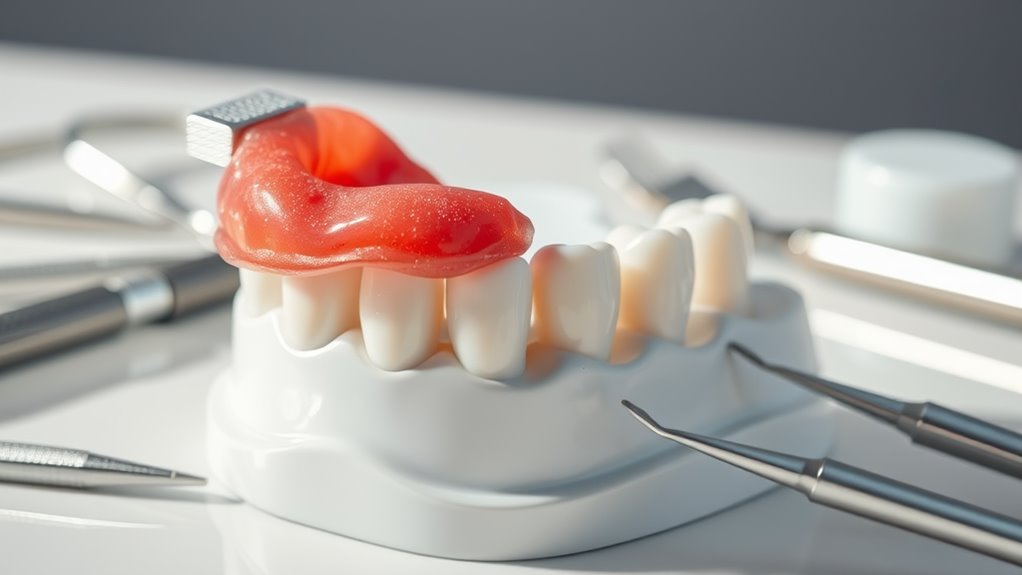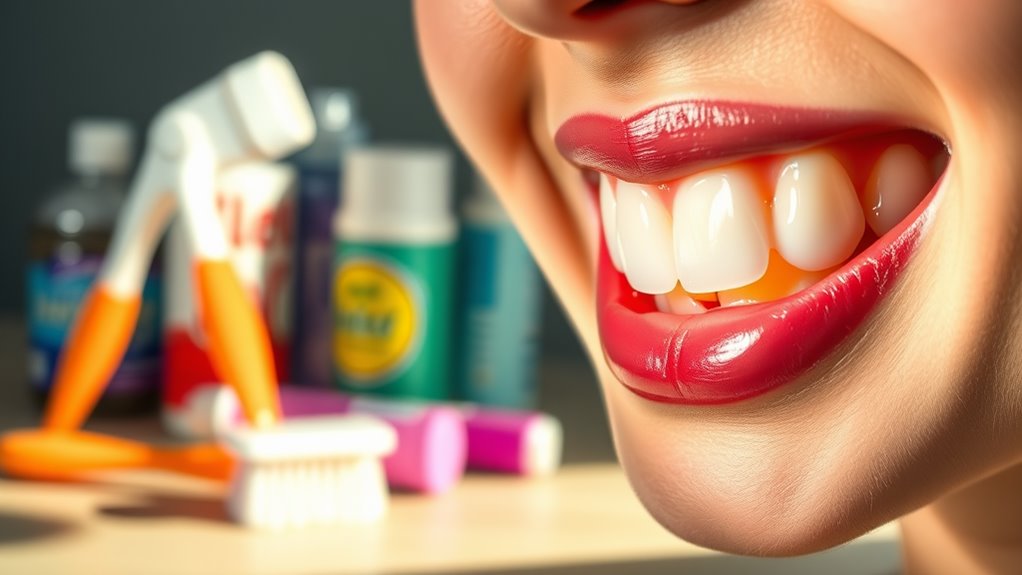Shocking! The Truth About Electric vs. Manual Toothbrushes!
Electric toothbrushes offer a more effective clean than manual ones, blasting away plaque with rapid strokes. They come with timers and pressure sensors, making it easier to brush correctly without damaging your gums. While manual brushes are cheaper and preferable for those who like control, electric options can save time and effort. However, don’t overlook the environmental impact of your choice. Stick around to discover how to choose the best toothbrush for your needs and sustainability.
Effectiveness of Electric vs. Manual Toothbrushes
When it comes to choosing between electric and manual toothbrushes, studies show that electric brushes often provide a more effective clean. They deliver rapid brush strokes that help remove plaque and reduce gingivitis more efficiently than manual options.
With built-in timers, they guarantee you brush for the recommended two minutes, promoting better overall oral hygiene. You’ll also find that many electric brushes feature pressure sensors, preventing you from brushing too hard, which can damage your gums.
If you struggle with technique, an electric toothbrush can guide you, making it easier to reach all areas of your mouth.
Ultimately, if you’re looking for an effective way to enhance your dental routine, an electric toothbrush might be worth considering for that extra boost in cleaning power.
Cost Analysis: Electric vs. Manual Toothbrushes
While both electric and manual toothbrushes serve the same fundamental purpose, their costs can vary considerably.
When you’re deciding which to choose, consider these factors:
-
Initial Cost: Manual toothbrushes are typically cheaper, often under $5, while electric ones can range from $20 to over $200.
-
Replacement Heads: Electric toothbrushes require replacement heads, which can cost $5 to $15 each, adding to long-term expenses.
-
Batteries/Charging: Electric brushes may need batteries or charging, which can slightly increase your overall costs.
-
Longevity: Manual brushes need replacing every 3-4 months, while high-quality electric models can last years with proper care.
Ultimately, weigh these costs against your budget and dental care needs to make the best choice for your oral hygiene routine.
Environmental Impact of Toothbrush Choices
Choosing between electric and manual toothbrushes goes beyond personal preference; it also impacts the environment.
Electric toothbrushes often come with rechargeable batteries and plastic components, which can contribute to electronic waste if not disposed of properly. Over time, these materials can lead to pollution and harm ecosystems.
On the other hand, while manual toothbrushes are usually made of plastic, some brands offer biodegradable options that minimize environmental harm.
When you consider how often you replace your toothbrush, the cumulative waste can add up considerably.
By opting for a sustainable manual toothbrush or an electric model with replaceable heads, you can make a choice that reflects your commitment to reducing your environmental footprint.
Every small decision counts in the fight against pollution.
Scientific Evidence Supporting Toothbrush Types
Research has shown that both electric and manual toothbrushes can effectively clean your teeth, but the level of effectiveness often depends on how you use them.
Studies indicate that proper technique plays a vital role in maintaining oral health. Here are some key points to keep in mind:
- Brushing Duration: Aim for at least two minutes, regardless of the toothbrush type.
- Pressure: Use gentle pressure to avoid damaging your gums.
- Technique: Circular motions are effective for both types; just guarantee you cover all areas.
- Frequency: Brush twice daily for ideal results.
Ultimately, it’s your brushing habits that matter most, whether you choose electric or manual.
Make every stroke count for a healthier smile!
User Experience: Comfort and Ease of Use
When it comes to comfort and ease of use, many people find electric toothbrushes more appealing due to their automated features and ergonomic designs. You’ll appreciate how these brushes take the effort out of brushing, allowing you to focus on reaching every corner of your mouth. On the other hand, manual toothbrushes give you complete control over pressure and technique, which some users prefer.
Here’s a quick comparison of user experiences:
| Electric Toothbrush | Manual Toothbrush |
|---|---|
| Requires less effort | Requires more effort |
| Built-in timers | No timer available |
| Ergonomic grip | Standard handle design |
| Various modes/settings | One setting |
| Rechargeable/battery-powered | No charging needed |
Ultimately, it comes down to your personal preference!
Recommendations for Different Dental Needs
Depending on your specific dental needs, the choice between an electric and manual toothbrush can greatly impact your oral health routine.
Here are some recommendations to help you decide:
-
Braces: If you have braces, an electric toothbrush can make it easier to clean around brackets and wires.
-
Gum Sensitivity: For sensitive gums, a soft-bristled manual toothbrush might offer better control and gentleness.
-
Plaque Control: If you’re prone to plaque buildup, an electric toothbrush can provide superior plaque removal due to its consistent motion.
-
Children: For kids, a colorful electric toothbrush might encourage better brushing habits, but a manual one can also be effective with proper guidance.
Consider your unique situation, and choose the option that best supports your oral health goals!
Maintenance and Longevity of Toothbrushes
Maintaining your toothbrush properly can greatly affect its performance and longevity, regardless of whether you choose an electric or manual option.
For manual brushes, rinse the bristles thoroughly after each use and store it upright to allow it to dry completely. Avoid covering the brush, as moisture can promote bacteria growth. Replace your manual toothbrush every three to four months, or sooner if the bristles fray.
For electric toothbrushes, clean the handle and charging base regularly with a damp cloth. Replace the brush head every three months or when the bristles become worn.
Store your electric toothbrush in a dry area, away from dampness. By following these simple maintenance tips, you’ll guarantee your toothbrush remains effective and lasts longer.
Frequently Asked Questions
Can Children Use Electric Toothbrushes Safely?
Yes, children can use electric toothbrushes safely. Just make certain they’re the right size for their hands and teeth. Supervise them initially to help develop proper brushing techniques, making oral hygiene fun and effective!
Are There Any Risks With Electric Toothbrushes?
Yes, there are some risks with electric toothbrushes. You might accidentally apply too much pressure, which can damage your gums. Additionally, improper use could lead to ineffective cleaning, so it’s crucial to follow the manufacturer’s instructions.
How Often Should I Replace My Toothbrush?
You should replace your toothbrush every three to four months, or sooner if the bristles become frayed. Keeping your toothbrush fresh helps maintain good oral hygiene and guarantees effective plaque removal during brushing.
Do Electric Toothbrushes Require Special Toothpaste?
Electric toothbrushes don’t require special toothpaste. You can use any fluoride toothpaste you prefer. Just make sure to apply a pea-sized amount, and you’ll effectively maintain your oral hygiene with either type of toothbrush.
Can Electric Toothbrushes Help With Braces or Dental Work?
Yes, electric toothbrushes can help you maintain oral hygiene with braces or dental work. Their gentle vibrations effectively clean around brackets and wires, making it easier to reach tricky spots and keep your smile healthy.




